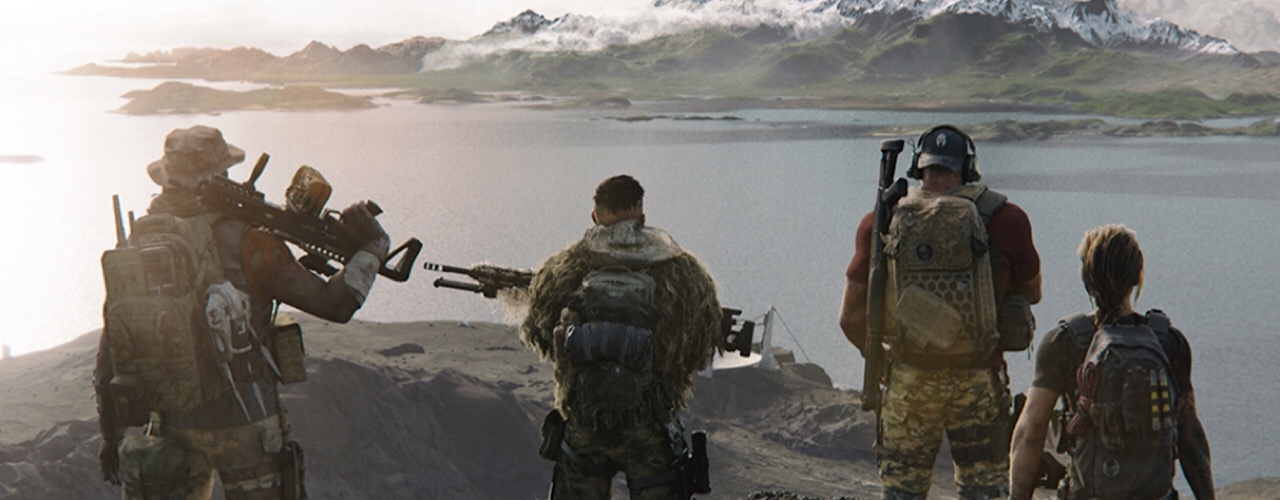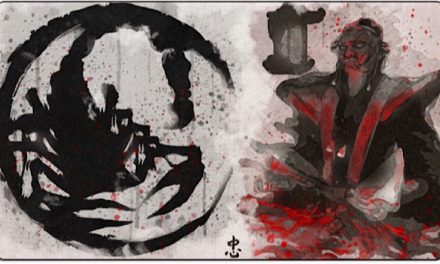Much as with his books, though author Tom Clancy died in 2013, new video games continue to be published under his name, based in part around his ideas, characters, and story elements. Previously I’ve written at length about Tom Clancy’s Ghost Recon: Wildlands (what a mouthful) from a narrative standpoint, and today I’m taking a step back to explore the latest game bearing his name from gameplay, story, and entertainment perspectives—Breakpoint.
Most of Tom Clancy’s work focuses on the adventures strong, white, male protagonists, from Jack Ryan to Sam Fisher. Many games in the Ghost Recon franchise at least let players define to a degree how they look, even if their appearance changes nothing about the game but the voice actor the player will hear. I honestly can’t give the studio execs at Ubisoft any credit for diversity on this one, especially when contrasted with their game Watch_Dogs 2 wherein the main character is a young black male and has friendships with individuals who have a very different worldview and upbringing than many players are used to.
Breakpoint continues the trend of “generic action hero gets stranded and must fend for himself” that we’ve seen all too frequently across third-person shooters, by this time putting our protagonist on a remote archipelago under a recently-established military dictatorship. Of course the hero must find a way off the island, a way to shut off the drone/swarm/force field/macguffin which holds the populace hostage, and get revenge on an old commander who has turned rogue. Honestly pretty generic stuff, but again we aren’t talking about Faust here.
A good friend and I play Breakpoint exclusively together, as our tradition is to enjoy co-op shooters with one another as a way of staying connected and enjoying one another’s company. We bonded over Quake III back in 2000 and that tradition remains a stable part of our relationship. We have so far ignored the story and have been bumming around the island chain looking for and completing side-missions, finding and eliminating camps of bad army guys, and tracking down the fanciest or most effective weapons which fit our particular play style.
While he and I have a very solid dynamic and very well understand what to expect from each other, I think I would enjoy playing with one additional person. The three roles we’d need to cover are long-range, short-range, and reconnaissance. For our Breakpoint run he is playing a high-precision sniper and I’m a more stealthy, run-and-gun assault type. This usually results in me doing the recon due to his having found an advantageous perch from which to rain destruction down on the occupying force. The more time I spend doing recon however—with binoculars, drones, and other passive observance— the less time I spend actually shooting people, which is after all the point of the game.
Games like The Division 2 and Ghost Recon: Wildlands squeezes more functionality out of it’s surveillance tech; not only were gadgets useful for spotting enemies, they could also cause distractions, lay down a cloud of smoke, or even take small pot-shots to augment a soldier on the move. Unfortunately, the only distractions I can do in this game seems to be running the drone into something hard enough to make noise. Not a lot of options there, particularly when in the more rural settings where trees don’t make much impact noise.
There’s no real way to sugar-coat this, so I’ll say it plainly: Breakpoint has problems with basic gameplay elements such as walking, interacting with objects, and weapon balance.
If I want to investigate a plot-related note or computer terminal, and there happens to be another object near by—whether a dead body, vehicle, or interact-able crate—the game will choose every option except “look at the plot thing” as the action which takes priority. There have been multiple times where I have had to drive vehicles and carry bodies out of the area just so the protagonist can read a piece of paper in plain view. If my crosshairs aren’t helping me tell the game what I am currently trying to focus on and interact with, what good are they in this scenario?
Movement is also a problem, in that stopping, turning, or rotating the characters is sluggish and prone to undesirable outcomes, such as taking two or three steps in an unexpected direction, putting one hand on a ladder but refusing to climb it, or having the camera twist unnaturally. Climbing things in general is an absolute pain—particularly frustrating when games of yesteryear like Dying Light and The Division 2 nailed it so well—and don’t get me started on trying to descend a mountain or slope.
Also, and this may be real nit-picky, but since when In video games has a player had to hit the “climb” button to ascend a staircase, instead of trying to take cover in a way that provides no cover at all? It’s just bizarre how that decision made it past QA testing.
Talking of QA testing, a large draw of many third-person shooters is the vast amount of story, side, and incidental quests a player may stumble upon. Every game studio handles tracking and making relevant information available to the player in a different way, but Breakpoint left both my friend and I simply scratching our heads, and that’s even after replaying the mission menu tutorial several times. Far, far too many steps, no option to reorder the displayed quests without fully removing and re-adding them, and trying to back out of the quest screen takes somewhere in the neighborhood of 5 presses of Escape. That’s too many nested menus!
The graphics aren’t anything special—as far as games in the 2018–2020 era is concerned—but I do have to point out the water. I think the programmers handled the volume and mass that water has very well, particularly when trying to swim against the current or when racing boats, but the graphic designers needed a few more rounds on the actual texture pack or look of water. While the fluid moves well underneath, the surface of the ocean, rivers, and streams looks like it has no connection to the physics below, like the two aren’t even connected. I fully understand that water is incredibly difficult, but this is worse than the water portals available in 1996’s Super Mario 64. Not a high bar to jump over, but it seems like they tried to limbo under it instead.
In games going back to competitive Quake 2 in 1997, balancing sniper rifles has been a Herculean task. Games across the ages have experimented with differing amounts of raw damage, reload time, magazine capacity, total ammunition, and rate of fire, and while I admit I struggle to think of a game that really has the risk/reward equation properly dialed in—with perhaps Quake III: Arena and Battlefield 2142 as rare examples—Breakpoint continues a long tradition of these weapons being exhaustively overpowered. There is functionally no reason to not have one in your loadout at all times, because most enemies you face are standing outside or at least near a window. My friend routinely delivers headshots from more than 300 meters with functionally no bullet drop, and enough power to shoot through multiple walls. If someone tries to approach his position, they’d better hope a lot of cover lies between him and them or he’ll have more than ample opportunity to cut their run short.
The class I’m playing as—the Panther—has bonuses to stealth and is designed for infiltration and up-close, personal combat. While I like the overall utility of the class, and its unique skill comes in handy far more often than I would expect, one aspect of the class’ progression quest is highly frustrating to me. The class has the unique ability to throw a flashbang-like device, instantly yet temporarily making you immune to the watchful eyes of hostiles. Most often this is used as an emergency escape option, one to save your skin when an infiltration goes well and truly pear-shaped.
As a recurring theme in the Panther’s class quests, it requires kills while under the effect of this unique ability. So, functionally, to achieve those challenges the game all but requires me to get caught in order to use the ability most effectively, when the whole point of the class is about not getting caught in the first place. It just seems so backwards and frustrating to me, particularly when it relates to gameplay-as-described compared to gameplay-as-experienced.
One thing I do have to give the game praise for, however, is the NPC banter. Not the primary, generic story-based NPCs, but the way guards and civilians have small side conversations if they aren’t alerted to your presence. It may not be as entertaining as scanning everyone’s profile in Watch_Dogs 2, but it is a nice touch. This aspect was brought to mind when my friend was mowing down enemies and I, much closer, heard an exasperated survivor yell out “they shot Ronnie! I’m gonna kill those bastards!” It really made me chuckle.
Ultimately, the question comes down to “would I recommend this game?” After playing somewhere on the order of 8-10 first- and third-person shooters in co-op with my friend, I think the only way to enjoy this game is to have a dedicated group of friends who want to get in on the action. The enjoyment of the game is almost more about the social interaction than it is about any rewarding or innovative aspect of the final product.
Many games have some measure of interesting or compelling hook to grab and keep a player’s attention and focus, and unfortunately I have to say that Breakpoint really doesn’t.
















